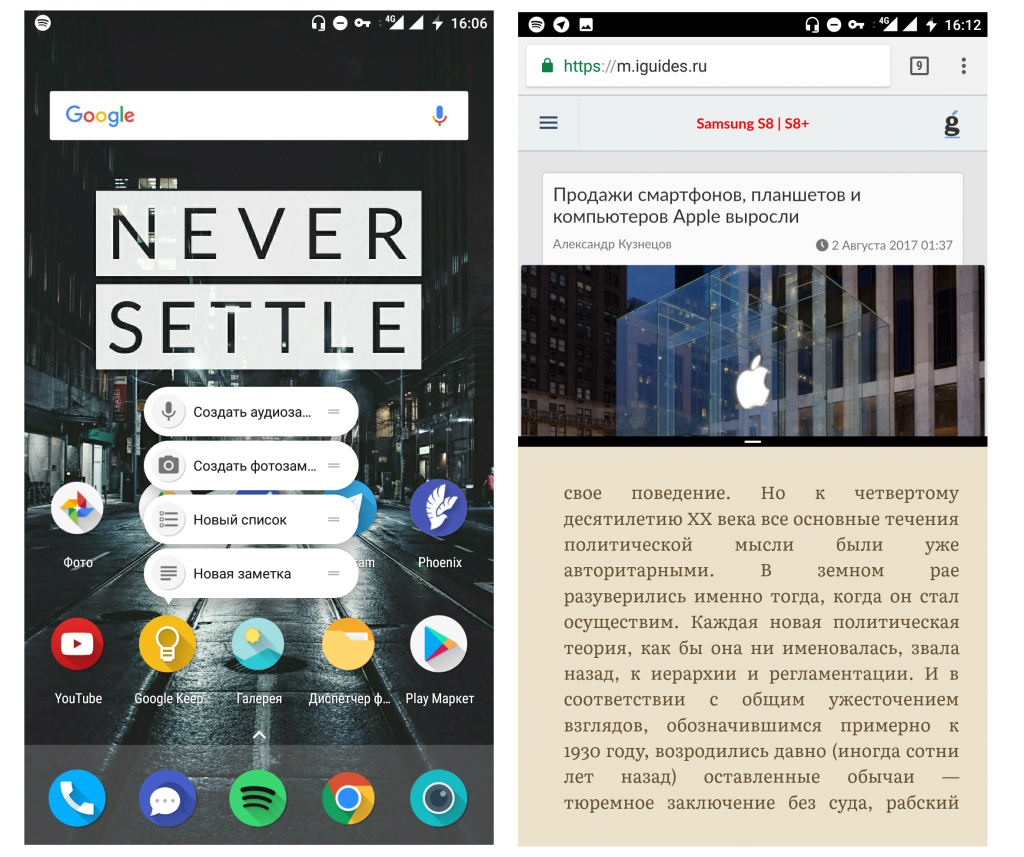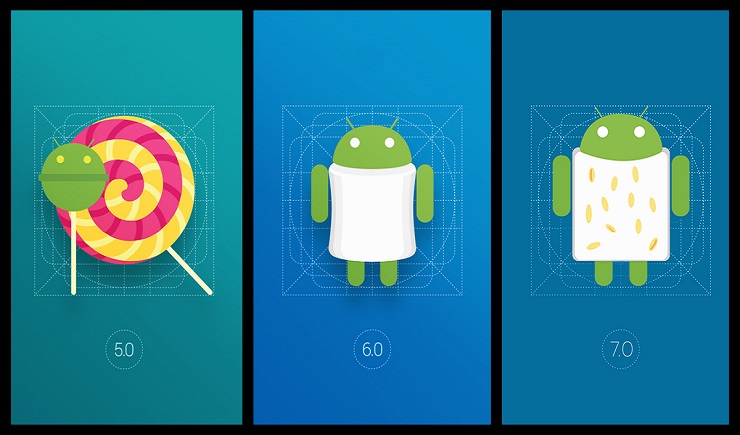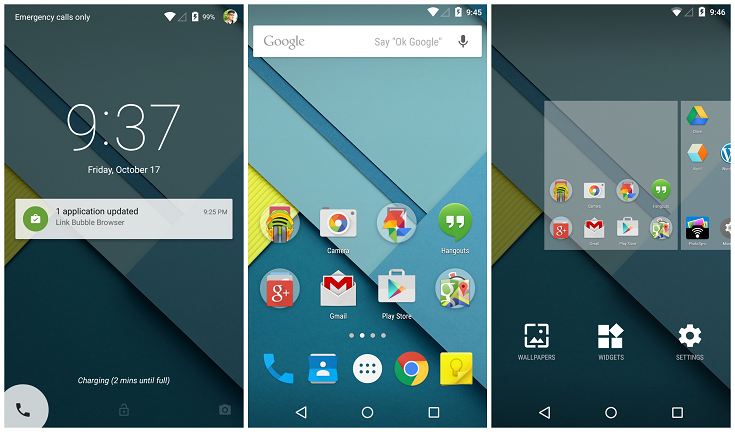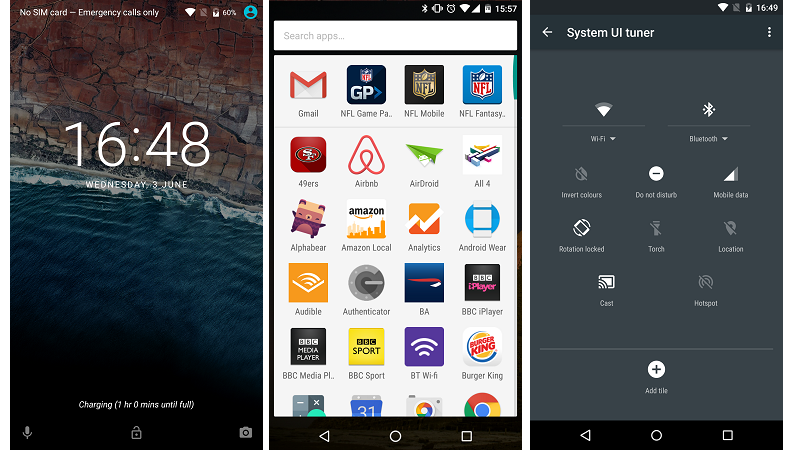- История Android от 5.0 до 7.1
- Android versions: A living history from 1.0 to 12
- Explore Android’s ongoing evolution with this visual timeline of versions, starting B.C. (Before Cupcake) and going all the way to 2021’s Android 12 release.
- Android Versions
- Android versions 5.0 and 5.1: Lollipop
- Android version 6.0: Marshmallow
- Android versions 7.0 and 7.1: Nougat
- Android version 8.0 and 8.1: Oreo
- Android version 9: Pie
- Android version 10
- Android version 11
- Android version 12
История Android от 5.0 до 7.1
В предыдущих частях статьи мы рассмотрели старые версии Android (1.0-2.3 и 3.0-4.4). Теперь же мы перейдем к новейшей истории Android, к самым популярным версиям на данный момент — на Android 5.0 и выше работает порядка 75% устройств, и программы оптимизируют в основном под них.
Android 5.0-5.1 Lollipop (2014-2015)
В 2012 году Microsoft представила Windows 8 — систему, основанную на «плоском» дизайне. В 2013 году Apple представила iOS 7 с «попугайно-плоским» дизайном. Разумеется, Google не могли остаться в стороне, и в Android 5.0 был представлен новый внешний вид, который назвали Material Design. Суть дизайна сводится к простоте, минимализму и единым элементам управления: GUI как будто был собран из разноцветных кусочков бумаги, и все это приправлено многофункциональной кнопкой FAB (Floating Action Button). Также новый дизайн был призван решить проблемы с отображением GUI программ на экранах разных размеров — плоские элементы очень легко масштабируются.
Достаточно много изменений было и «под капотом» — во-первых, система теперь может использовать виртуальную машину только ART — Dalvik полностью сошел на нет. Увы, это привело к проблемам с дешевыми массовыми устройствами на 4ядерных Mediatek — они не умели работать с ART, поэтому поддержка большинства их остановилась на Android 4.4. Во-вторых, появился Project Volta: если раньше операционная система обращалась к процессору одиночными запросами, то теперь она может обращаться только пакетами данных — это, в теории, должно было экономить заряд, однако даже пользователи Nexus 5 — устройства, поддержкой которого занимается сам Google — серьезного увеличения времени автономной работы при переходе на Lollipop не заметили.
Также было добавлено несколько «фишек», позволяющих упростить работу с системой: так, теперь можно работать с уведомлениями прямо с экрана блокировки: к примеру, можно сразу перейти к приложению, которое прислало уведомление. На устройствах Nexus добавилась функция Ambient Display — при взятии телефона в руку он сам включает дисплей. А пользователи, которые любят получать все первыми, теперь имеют возможность ставить тестовые сборки Developer Preview.
С версии 5.0 Google стала развивать то, для чего, собственно, Android изначально и разрабатывался — версию ОС для носимых устройств, которую они назвали Android Wear. Увы — первая версия системы была достаточно сырой и имела множество ограничений, поэтому изначально большой распространенности не получила: за весь 2014 год было продано всего 720 тыс носимых устройств. Также Google стала развивать Android TV и Android Auto — версии для телевизоров и машин. Однако далеко не все производители оценили урезанную Android TV — даже сейчас в не очень дорогих телевизорах можно скорее встретить Android 4.4, чем TV. Ну а в дорогих телевизорах по непонятным причинам стоит настолько слабое железо, что зачастую лагает даже 1080р видео — в общем, идея создания «умных телевизоров» оказалась достаточно провальной, и многие покупают дешевые ТВ-приставки (самая известная — Apple TV) и подключают их к обычным телевизорам.
В версии 5.1 появились сразу две важные вещи: во-первых, теперь система умеет работать с двумя SIM-картами (раньше этот функционал производитель добавлял сам). Во-вторых, появилась система защиты от кражи, сравнимая с таковой от Apple — называется она Device Protection: если пользователь заблокировал девайс, то, пока он не введет на нем свой аккаунт Google, устройство становится по сути кирпичом. Да, раньше были способы обхода такой блокировки, но сейчас 100% способа обхода нет. Из небольших изменений — поддержка HD Voice, то есть передачи голоса при звонке в HD-качестве. Однако тут множество проблем: во-первых, эту технологию должны поддерживать оба телефона, во-вторых, ее должны поддерживать оба оператора, и в-третьих — оба телефона должны быть в 3G или 4G. В итоге эта функция работает далеко не всегда, однако с учетом распространения интернет-звонков, это и не важно.
Android 6.0-6.0.1 Marshmallow (2015)
«Зефирка» хоть и имела новый порядковый номер, изменения в ней тянули скорее на 5.2, чем на 6.0. Во-первых, система научилась работать со сканерами отпечатков пальцев (раньше эту возможность приходилось внедрять самим разработчикам смартфонов, что приводило к казусам — к примеру, у HTC отпечаток пальца хранился. в виде обычного файла в пользовательской директории!) Во-вторых, появилась функция Google Now on Tap. Ее смысл в том, что система может анализировать то, что есть на экране в данный момент, и показывать информацию об этом: к примеру, может найти песню, название которой есть на дисплее, или найти на карте место, адрес которого также виден на экране. В принципе функция хорошая, и она даже работает, но все еще она требует доработки.
В глубинах системы произошло только одно изменение: режим Doze, который призван увеличить время автономной работы устройства в режиме ожидания. Его суть заключается в том, что если устройством долго не пользоваться, то активируется «глубокий» спящий режим, при котором фоновая деятельность приложений останавливается или сильно ограничивается.
Также в Google еще сильнее доработали безопасность — теперь каждый месяц выпускается обновление безопасности для системы с исправлением уязвимостей. Начинание, конечно, благое, но вот далеко не все производители его поддержали, и в результате сейчас можно встретить устройства на 6.0, которые получили последний патч безопасности аж в 2015 году. Однако флагманы в основном получают эти обновления исправно, так что безопасность устройств на Android в среднем выросла. Второе важное изменение, касающееся безопасности — теперь можно ограничивать приложениям доступ к различным системным элементам. К примеру, если игра вдруг просит разрешение на отправку СМС — это можно запретить.
Google, как и Apple, стали развивать свой платежный сервис — назвали его, разумеется, Android Pay. По своим возможностям он близок к Apple Pay: такая же привязка карты и возможность оплаты с заблокированного экрана с помощью отпечатка пальца. Однако, увы, Google мало заботится о распространении своего сервиса, да и с поддерживаемыми устройствами было все не очень хорошо: в итоге до России сервис добрался спустя полгода после Apple Pay, а пользователи китайских устройств мучаются с ошибками при привязке банковских карт.
Android 7.0-7.1.2 Nougat (2016-2017)
«Нуга» была заточена скорее под большие смартфоны (фаблеты) и планшеты, так как в ней появилась возможность вывода двух приложений на один экран одновременно. Да, у Apple эта функция появилась годом раньше, а некоторые производители фаблетов (к примеру, Samsung) добавили ее еще раньше, однако у Google было одно важное преимущество — многозадачность работает на всех устройствах. Да, ее наличие на 4″ смартфоне вызывает некоторые вопросы, но все Google молодцы, что дали эту возможность всем.
Переработали панель быстрого доступа — теперь в нее можно добавить свои иконки и менять их местами (Apple дошла до этого год спустя, в iOS 10), доработали многозадачность — добавили кнопку закрытия всех приложения, а также возможность вызова превью всех открытых программ на одном экране (аналог Alt+Tab в Windows). Появился режим Ночного света (почти на год позже, чем у Apple), который делает экран теплее и помогает ночью лучше засыпать. 
Изменений внутри было больше, чем снаружи. Во-первых, система «переехала» на Java 8, а также обновили ART — в итоге больше нет «оптимизации приложений» после каждого обновления системы, которое занимало достаточно много времени, особенно если количество программ велико. В систему добавили Project Svelte — сервис, который должен в теории следить за объемом ОЗУ и экономить ее. Увы — тесты показали, что толку от него немного: iPhone с 2-3 ГБ ОЗУ оказываются зачастую серьезно быстрее устройств на Android с 4-6 ГБ ОЗУ на втором круге в тесте скорости работы с приложениями: если на iOS приложения все еще находятся в ОЗУ, и к ним обеспечивается молниеносный доступ, то на Android многие приложения грузятся заново.
Android 7.1 можно назвать эксклюзивной версией системы для Nexus — они получили и нового поумневшего помощника — Google Assistent, и поддержку новой виртуальной реальности DayDream (чем Google не устраивал их CardBoard — непонятно), и новый Pixel Launcher. Однако Android есть Android — очень быстро все эти «фишки» стали доступны другим пользователям устройств на 7.1.
Также добавился аналог 3D Touch — если сканер отпечатков в iPhone понравился многим, и сейчас его ставят чуть ли не в 100 долларовых китайцах, то вот 3D Touch в том виде, что и у Apple, реализовала по сути только Meizu. Так что Google пришлось изгаляться — если на iOS для вызова быстрых функций приложения нужно надавить на иконку, то тут нужно просто долго держать на ней палец. По своим возможностям эти «ярлыки» были схожи с возможностями 3D Touch: к примеру, запуск камеры сразу в режиме видео, переход сразу к сообщениям определенного человека, и так далее.
В 7.1.1 серьезно доработали копирование — если раньше можно было копировать только текст, то теперь можно, к примеру, скопировать в браузере картинку и сразу вставить ее в мессенджер.
Ну а о 8.0 говорить еще рано — она находится в бета-тестировании, и оценить все нововведения пока еще толком нельзя. Поэтому цикл статей о истории Android мы заканчиваем на 7ой версии.
Источник
Android versions: A living history from 1.0 to 12
Explore Android’s ongoing evolution with this visual timeline of versions, starting B.C. (Before Cupcake) and going all the way to 2021’s Android 12 release.
Contributing Editor, Computerworld |
Android Versions
Android versions 5.0 and 5.1: Lollipop
Google essentially reinvented Android — again — with its Android 5.0 Lollipop release in the fall of 2014. Lollipop launched the still-present-today Material Design standard, which brought a whole new look that extended across all of Android, its apps and even other Google products.
The card-based concept that had been scattered throughout Android became a core UI pattern — one that would guide the appearance of everything from notifications, which now showed up on the lock screen for at-a-glance access, to the Recent Apps list, which took on an unabashedly card-based appearance.
JR Raphael / IDG
Lollipop and the onset of Material Design.
Lollipop introduced a slew of new features into Android, including truly hands-free voice control via the «OK, Google» command, support for multiple users on phones and a priority mode for better notification management. It changed so much, unfortunately, that it also introduced a bunch of troubling bugs, many of which wouldn’t be fully ironed out until the following year’s 5.1 release.
Android version 6.0: Marshmallow
In the grand scheme of things, 2015’s Marshmallow was a fairly minor Android release — one that seemed more like a 0.1-level update than anything deserving of a full number bump. But it started the trend of Google releasing one major Android version per year and that version always receiving its own whole number.
Marshmallow’s most attention-grabbing element was a screen-search feature called Now On Tap — something that, as I said at the time, had tons of potential that wasn’t fully tapped. Google never quite perfected the system and ended up quietly retiring its brand and moving it out of the forefront the following year.
JR Raphael / IDG
Marshmallow and the almost-brilliance of Google Now on Tap.
Android 6.0 did introduce some stuff with lasting impact, though, including more granular app permissions, support for fingerprint readers, and support for USB-C.
Android versions 7.0 and 7.1: Nougat
Google’s 2016 Android Nougat releases provided Android with a native split-screen mode, a new bundled-by-app system for organizing notifications, and a Data Saver feature. Nougat added some smaller but still significant features, too, like an Alt-Tab-like shortcut for snapping between apps.
JR Raphael / IDG
Android 7.0 Nougat and its new native split-screen mode.
Perhaps most pivotal among Nougat’s enhancements, however, was the launch of the Google Assistant — which came alongside the announcement of Google’s first fully self-made phone, the Pixel, about two months after Nougat’s debut. The Assistant would go on to become a critical component of Android and most other Google products and is arguably the company’s foremost effort today.
Android version 8.0 and 8.1: Oreo
Android Oreo added a variety of niceties to the platform, including a native picture-in-picture mode, a notification snoozing option, and notification channels that offer fine control over how apps can alert you.
JR Raphael / IDG
Oreo added several significant features to the operating system, including a new picture-in-picture mode.
The 2017 release also included some noteworthy elements that furthered Google’s goal of aligning Android and Chrome OS and improving the experience of using Android apps on Chromebooks, and it was the first Android version to feature Project Treble — an ambitious effort to create a modular base for Android’s code with the hope of making it easier for device-makers to provide timely software updates.
Android version 9: Pie
The freshly baked scent of Android Pie, a.k.a. Android 9, wafted into the Android ecosystem in August of 2018. Pie’s most transformative change was its hybrid gesture/button navigation system, which traded Android’s traditional Back, Home, and Overview keys for a large, multifunctional Home button and a small Back button that appeared alongside it as needed.
Android 9 introduced a short-lived setup for getting around phones with a mix of both gestures and buttons.
Pie included some noteworthy productivity features, too, such as a universal suggested-reply system for messaging notifications, a new dashboard of Digital Wellbeing controls, and more intelligent systems for power and screen brightness management. And, of course, there was no shortage of smaller but still-significant advancements hidden throughout Pie’s filling, including a smarter way to handle Wi-Fi hotspots, a welcome twist to Android’s Battery Saver mode, and a variety of privacy and security enhancements.
Android version 10
Google released Android 10 — the first Android version to shed its letter and be known simply by a number, with no dessert-themed moniker attached — in September of 2019. Most noticeably, the software brings about a totally reimagined interface for Android gestures, this time doing away with the tappable Back button altogether and relying on a completely swipe-driven approach to system navigation. (If you so choose, that is; unlike Pie, Android 10 also includes the traditional Android three-button navigation system as an option on all phones.)
Under the hood, Android 10 introduces a new setup for hot-fix-style updates that’ll eventually allow for faster and more consistent rollouts of small, narrowly focused patches. And the software has plenty of other quietly important improvements, including an updated permissions system that gives you more control over exactly how and when apps are able to access location data as well as an expanded system for protecting unique device identifiers (which can be used to track a device’s activity over time).
Android 10’s new privacy permissions model adds some much-needed nuance into the realm of location data.
Beyond that, Android 10 includes a system-wide dark theme, a new Focus Mode that lets you limit distractions from specific apps with the tap of an on-screen button, and a long-overdue overhaul of Android’s sharing menu. It also introduces a new Live Caption feature that allows you to generate on-the-fly visual captions for any media playing on your phone — videos, podcasts, or even just regular ol’ voice recordings. The feature debuted initially on Google’s own Pixel phones and has slowly made its way to more devices from there.
Android version 11
Android 11, launched at the start of September 2020, is a pretty substantial Android update both under the hood and on the surface. The version’s most significant changes revolve around privacy: The update builds upon the expanded permissions system introduced in Android 10 and adds in the ability for users to grant apps certain permissions — those related to location access, camera access, and microphone access — only on a limited, single-use basis.
Android 11 lets you grant an app permission to see your location or access your camera or microphone only for a single session of use.
Android 11 also pushes the background location permission even deeper into the system and makes it more difficult for apps to request (and thus less likely for users to activate inadvertently). And it introduces a new feature in which apps that have gone unopened for a matter of months will automatically have their permissions revoked unless you actively opt to reauthorize them.
Beyond that, Android 11 removes an app’s ability to see what other apps are installed on your phone — something that was actually possible up until this release — and it limits the ways apps are able to interact with your local storage in order to better protect your information.
Importantly but invisibly, Android 11 more than doubles the number of once-OS-bundled elements that now exist as their own standalone modules — like apps in the Play Store, basically — and thus can be updated directly by Google, frequently and universally and without the need for any carrier or manufacturer involvement. And as for the more visible, user-facing features, Android 11 refines the system notification area to emphasize and simplify conversation-related alerts; it introduces a new streamlined media player that contains controls for all audio- and video-playing apps in a single space; and it adds in a new contextual menu of connected-device controls for any smart products associated with your account (though some of those features require a bit of manual adjustment in order to work optimally).
Android 11’s new media player appears as part of the system Quick Settings panel, while the new connected-device control screen comes up whenever you press and hold your phone’s physical power button.
Last but not least, Android 11 marks the long-awaited debut of Bubbles — a new kind of multitasking system first discussed in 2019 but then put on the back burner until now. With apps that support the system, Bubbles allows you to pop conversations out into floating windows that appear on top of whatever else you’re doing and can be condensed down into small, floating bubbles that remain easily accessible for expansion.
Android’s new Bubbles feature was first introduced during development of Android 10 — known as «Android Q» at the time — and finally made its public debut with Android 11.
Android 11 has plenty of other small but significant improvements — including a new Notification History section, a native screen recording function, and an automated scheduling system for the system-wide Dark Theme.
Android version 12
Google officially launched the final version of Android 12 in October 2021 and started rolling the software out to its own Pixel devices soon after — alongside the launch of its new Pixel 6 and Pixel 6 Pro phones.
In a twist from the last several Android versions, the most significant progressions with Android 12 are mostly on the surface. Android 12 features the biggest reimagining of Android’s interface since 2014’s Android 5.0 (Lollipop) version. That version, as we discussed a moment ago, was the first to showcase Google’s then-new Material Design standard. And this one is the first to integrate an updated and completely overhauled take on that standard — something known as Material You.
Material You brings a dramatically different look and feel to the entire Android experience, and it isn’t limited only to system-level elements, either. Eventually, Android 12’s design principles will stretch into both apps on your phone and Google services on the web. The same principles will show up on Chromebooks, Smart Displays, and Google-associated wearables as well. And since a huge part of the Material You concept is allowing you (get it?) to customize the palette and other specifics of the interface’s appearance — even having your phone generate dynamic personalized themes for you on the fly, based on the colors of your phone’s wallpaper at any given moment — the changes run deep and will absolutely be noticeable.
Notably, most of Material You’s most meaningful design advancements will likely be available only on Google’s own Pixel phones, at least to start. After years of having third-party device-makers muck around with the Android interface and introduce all sorts of arbitrary change for the sake of change, Google finally seems to be embracing the fact that its own Android design choices are not going to be universal — and in doing so, it’s turning the limited availability of that interface and everything around it into a Pixel feature instead of a Google liability.
Android 12 ushers in a whole new look and feel for the operating system — at least, as it’s experienced on Google’s own devices. (Click image to enlarge it.)
Surface-level elements aside, Android 12 brings a (long overdue) renewed focus to Android’s widget system along with a host of important foundational enhancements in the areas of performance, security, and privacy. The update provides more powerful and accessible controls over how different apps are using your data and how much information you allow apps to access, for instance, and it includes a new isolated section of the operating system that allows A.I. features to operate entirely on a device, without any potential for network access or data exposure.
Android 12’s new Privacy Dashboard provides simpler and more granular details and controls over how apps are accessing your data. (Click image to enlarge it.)
If past Android upgrade cycles are any indication, Android 12 will likely make its way ever-so-slowly to all of the non-Google-controlled devices — those made by Samsung, Motorola, and other third-party manufacturers — over the coming months and throughout the first half of 2022.
And then, before we know it, we’ll have our eyes on the next major Android version — 2022’s Android 13.
This article was originally published in November 2017 and most recently updated in October 2021.
Contributing Editor JR Raphael serves up tasty morsels about the human side of technology. Hungry for more? Join him on Twitter or sign up for his weekly newsletter to get fresh tips and insight in your inbox every Friday.
Источник












